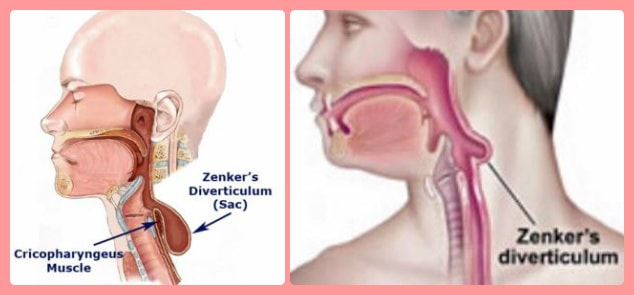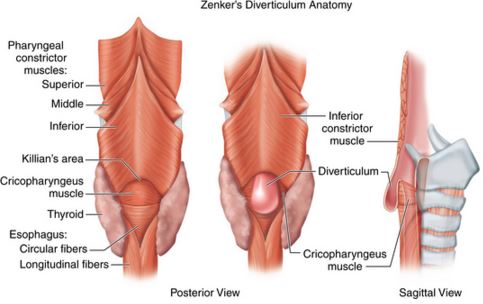Pharyngeal Pouches
What are Pharyngeal Pouches?
Pharyngeal pouches or also known as Zenker’s diverticulum is a fluid-filled pouch that sticks out in the delicate part of the esophageal lining. It is a type of condition wherein the lower area of the pharynx is weakened, which lead the muscles to protrude outwards and mold a pouch.

This structure can occur in the esophageal lining somewhere between the stomach and throat. The condition is rare and can affect all ages, but is more common in elderly individuals over 70 years of age. An estimation of 1 out of 100,000 individuals is affected per year.
Causes of Pharyngeal Pouches
A few individuals are susceptible to developing a pharyngeal pouch compared to others. The first case had been reported long time ago but until now, it is still quite difficult to reason out why the condition occurs. Despite that, a number of theories have been formed such as the weakening in the muscles of the pharynx caused by the aging process.
The internal pressure created by the esophagus in order to transport food directly into the stomach is suspected to be the reason why the esophageal lining is herniated through a weakened wall, producing the pouch. A distal end obstruction is commonly found.
Pharyngeal pouches are typically common in individuals who have motility irregularities of the esophagus like achalasia in which a person is having difficulties in swallowing and sometimes experience a spasm-type pain.
There are some risk factors that should also be considered such as acid reflux, surgery, stroke, smoking, and too much consumption of alcohol. If the person’s risk is high of developing avid reflux, then there is a greater risk of a pharyngeal pouch.
Pathology
Pharyngeal pouches are developed by the herniation of pulsion diverticulum by its muscular coat at the Killian triangle in the middle of the cricopharyngeus and thyropharyngeus muscles that creates the inferior constrictor.
This occurrence may result to the production of a sac with a tapered neck that can snare food and liquid. The sac that is dilated might squeeze the cervical esophagus.

Symptoms
The most common symptom of pharyngeal pouches is dysphagia, which is the feeling that a lump is present in the throat and causes a person to have difficulties in swallowing.
A lung infection called aspiration pneumonia may also be the cause as well. Other causes include pulmonary aspiration in which a foreign material or secretions enter the lungs and trachea, bad breath, cough, weight loss, pain on the neck, and swallowing discomfort.
Some individuals might encounter a gurgling sound when the air travels through the diverticulum and this is widely known as Boyce’s sign. The pouch gets worse over time caused by repeated swallowing.
Diagnosis
The tests that are usually used in diagnosing and evaluating pharyngeal pouches involve:
Gastrointestinal endoscopy – An endoscope is inserted to the gastrointestinal tract for image projections.
Barium swallow – The person gulps down a barium preparation and the movement is analyzed using X-ray technology.
Esophageal manometry – This measures the amount of strength and timing of the muscular valve relaxations and tightening of the esophagus.
Treatment
The minor symptoms that caused esophageal diverticulum may be treated by lifestyle changes but if the symptoms are acute, some surgical options are available to get rid of the diverticula, ease the symptoms, and fix the defects. The surgical treatment shall be based on the location and size of the diverticula. These include:
Diverticulopexy with cricopharyngeal myotomy – This is used for the removal of larger diverticula.
Endoscopic diverticulotomy – This method separates the septum between the diverticular pouch and cervical esophagus.
Cricopharyngeal myotomy – This is used to remove small diverticula by a trans or open oral procedure.
Diverticulectomy with cricopharyngeal myotomy – This type of treatment had been carried out for almost a century and it requires an excision of the diverticular sac.
References:
Pharyngeal pouch – Symptoms, causes, treatment at http://www.medic8.com/healthguide/sore-throat/pharyngeal-pouch.html
http://my.clevelandclinic.org/services/heart/services/thoracic/swallowing/EsophagealDiverticulum
http://radiopaedia.org/articles/zenker-diverticulum-1
Bizzotto A, Iacopini F, Landi R, et al (2013 Aug). Zenker’s diverticulum: exploring treatment options. Acta Otorhinolaryngol Ital. 33(4):219-29.
Aly A, Devitt PG, Jamieson GG (2004 Jun). Evolution of surgical treatment for pharyngeal pouch. Br J Surg. 91(6):657-64.
Mirza S, Dutt SN, Minhas SS, et al (2002 Jul). A retrospective review of pharyngeal pouch surgery in 56 patients. Ann R Coll Surg Engl. 84(4):247-51.
